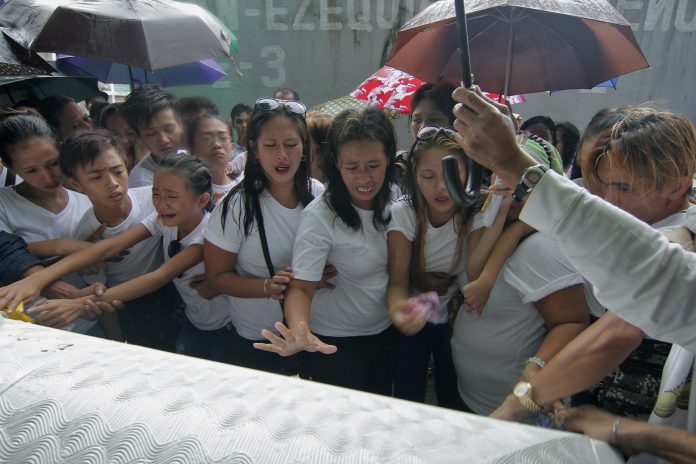How does Fathers’ Day look like among a fatherless generation?
“Pa, mahal na mahal kita. Alam mo Pa, noong buhay ka pa, sobrang alalang-alala ako sa yo kasi mahal na mahal kita…”
“Dear Papa, happy father’s day sa iyo. Mahal kita kahit wala ka na. Miss na miss na kita. Sana masaya ka na para sa amin.”
“Papa pinapangako ko po sa iyo na lahat ng gusto mo po para sa akin at sa mga kapatid ko ay matutupad dahil ikaw ang nagsilbing inspirasyon. Ikaw ang nagbigay ng dahilan para laban na kinakaharap namin…”
“Kunti lang pinagsamahan natin pero maraming salamat sa ‘yo Pa. Kung may pagkakataon na magkita tayo kahit saglit lang may hiling ako sa yon a yakapin ka. Ilang taon na po pal amula ng ikaw ay lumisan.. Ang hirap ng walang Tatay pero sige lang, wala naman po akong magagawa…”
“Pa, salamat sa pag-alaga sa amin at salamat na pinasaya mo kami. Papa naaalala pa rin kita at nami-miss kita kahit wala ka na dito.”
These are excerpts of some letters from the orphans on the Philippines’ War on Drugs on “Father’s Day”.
The Solidarity with Orphans and Widows (SOW) had a short retreat this weekend that culminated on Father’s Day.
The theme we reflected on was centered on the family. It was supposed to be a “family encounter” even as one member was painfully absent. These beleaguered families have to go on despite the odds. And I see their courage in the midst of pain, and determination in the midst of difficult lives.
How does Fathers’ Day look like among a fatherless generation? Fatherless, not because the fathers voluntarily left. No, they were involuntarily killed!
If some statistics were to be believed, there were 6255 drug-related deaths reported by the Philippine Drug Enforcement Agency until the end of Duterte’s reign. There were more in some human rights agencies.
The International Criminal Court at the Hague counted as far as 12,000 to 30,000 deaths as of September 2021. There were more victims even during the pandemic during the Marcos presidency.
If each victim has a family of five (the other victims as single young men), we have in fact a generation of fatherless children.
We have journeyed with the victims in Payatas. We tried our best to process their trauma, provide community networks and support, and offer opportunities for livelihood. Six years have passed. The journey is synthesized by one orphan who in his sharing said: “ang gulo!”
Life has already been so hard. Surviving the daily grind is already a heavy burden. As if this is not enough, the Duterte and Marcos administrations imposed an unjust yoke that they were forced to carry. “Dinagdagan pa ang gulo!” And the victims continue to cry for justice.
Now, the Senate investigations acknowledge that the police generals who were running the show are all messed up. “Ang gulo nga!” Yet all government policies still tell us that there is no end in sight. All State resources are employed to bar the ICC which is supposed to investigate and listen to the victims. “When, Lord, when?” Is the question in the depths of their hearts?
But regardless of how the past and present administrations demonized the drug addicts and small-time peddlers, they are seen as great heroes, loving fathers, and caring kuyas in the eyes of their children and families. Their testimonies above show this.
In a recent article that will be off the press soon, “Martyrs at the Margins”, I argued that the victims of these populist regimes, for example, the anonymous martyrs of the Duterte regime – some 30,000 victims whose bodies were slaughtered like animals, many of whom could not be claimed by their families for lack of funds or because they were unidentifiable beyond recognition, thus, were only buried in common graves or thrown into the sea– can also be considered martyrs.
Their horrible deaths were even more cruel and inhuman than the early martyrs. They were not considered human threats to the empire; they were used and disposed of as animals without significance and value. From the perspective of the regime, they are “hopeless cases”, less than human, pests of society who need to be eliminated. But from the view of his children, Juan was a loving father who risked his life because he wanted to see his children. He wanted to be there on the birthday of one of his daughters despite the danger. Like many of them, he died as a “witness to love”.
They were merely practicing their Christian responsibility to care and be compassionate, to love and be faithful, within their ordinary lives to the point of death.
They did not volunteer their own deaths. When Juan was told by his friends that he was on the “drug list”, he moved to Manila to escape from the police. He was careful not to provoke them. It is the same predicament of a thousand others.
But they could not renege on their duty to service and compassion. They were killed while “on duty” – one lawyer was going to court to defend a poor farmer; the other was ferrying his children to school; the other was driving a jeepney to earn a few pesos for food that night; and one young boy was begging the police to stop the torture since he still has classes the next day. In all these instances, the police did not listen, they shot them anyway. Martyrs of love and compassion.









